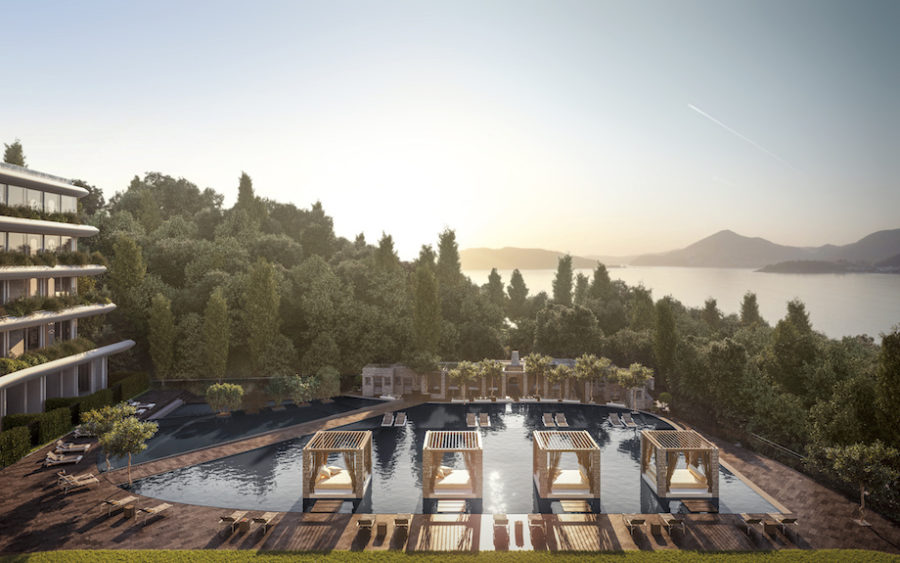
CULTURE

MVRDV designed a courtyard-type apartment 〈Ilot Queyries〉 with a friendly block and vast green space in France
MVRDVがフランスで設計した、親しみやすい街区と広大な緑地を備えた中庭型の集合住宅〈イロット・クイリーズ(Ilot Queyries)〉が誕生

© Ossip van Duivenbode
〈イロット・クイリーズ〉は、ソーシャルハウジング(主に低所得者を対象に、政府や公的機関によって提供される住宅制度)128戸を含む282戸の住宅と、駐車場、商業施設、屋上レストランを備えた中庭型の集合住宅。
光と風を受ける、また広大な緑地を備えた親しみやすい都市環境になっています。
ボルドーのガロンヌ川の東側、ユネスコ世界遺産に登録されている歴史地区の向かい側に位置しており、MVRDVがジュベール建築事務所とともに計画した、4棟の建物からなる新しい地区の一部です。

© Ossip van Duivenbode
このプロジェクトは、ボルドーのユネスコ世界遺産の歴史的都市の景観がもつ親密さ、驚き、活気を、現代都市における密度やエコロジー、光、快適さと結びつけることを目的とした、隣地にてMVRDVが設計したマスタープラン「バスティード・ニエル(Bastide Niel)」の実験場として想定され、同じアプローチを採用しています。
建物を敷地いっぱいに配置し、調整された傾斜の屋根とすることで、街並みに親しみやすさを与え、建物自体にも近隣にも最大限の通風や日照をもたらしています。

© Ossip van Duivenbode
地元の建築家であるフリントとの共同設計により、長さ約200mの大きな不定形の中庭を持つ建物が完成しました。
5,200m²の広大な中庭は地上1階に位置するため、居住者用の駐車場を隠しつつ居住者に公園のようなスペースを提供します。

© Ossip van Duivenbode
建物の南東側は、隣地の建築が低層のため高さを低く抑え、北東の川に面した部分では9階建ての高さになっています。高いフロアにはレストランが入っており、川とボルドーの歴史的中心部を見渡すことができます。

© Ossip van Duivenbode
マスタープラン「バスティード・ニエル」で策定されたルールに従い、屋根の傾斜は太陽との関係によって14度から45度の間で変化しています。
これらの傾斜により、複雑でユニークな内部空間が生まれ、さまざまなサイズの住居がつくられています。これによりさまざまなタイプの居住者が住むことが可能となります。

© Ossip van Duivenbode
通りに面したファサードはクリーム色の落ち着いた色調で、周囲の環境に溶け込んでいます。
対して、中庭に面したファサードは真っ赤なテクスチャーのスタッコで仕上げられています。
83本のハンノキやシラカバの木と様々な草で構成された緑の中庭の景観と相まって、視覚的に刺激的な環境となり、公園の活気を引き立てています。

© Ossip van Duivenbode
また、建物の各所に設けられた大きな入り口は、中庭と外部をつなぐもので、道行く人の目を引き、中の空間への好奇心をかきたてるような色彩を演出しています。

© Ossip van Duivenbode
MVRDVの設立パートナーであるヴィニー ・マース氏は、次のように語ります。
「新型コロナのパンデミックは、屋外スペースがいかに貴重であるかを示しました。この建物は、十分な駐車場を備えているため、醜い駐車違反をすることなく、親しみやすい通りをつくり出しています。同時に、すべての住戸にはバルコニーが設けられ、緑の公園スペースは素晴らしいコミュニティとなっています。」
「このプロジェクトは、バスティード・ニエル開発の大規模な計画の準備となり、私たちのアイデアのいくつかを試すことができました。
その結果、ストリートにより多くの緑を配し、ファサードのコストを最適化し、より開放的な中庭を持つマスタープランが完成しました。」

© Ossip van Duivenbode
〈イロット・クイリーズ〉は、MVRDVとジュベール建築事務所によって計画された、4つの建築からなる開発の中でも最も大きな建築です。
MVRDVと共同設計者のフリントによって設計され、ジュベール建築事務所とフリントは、この開発の他の建物も設計しています。
〈イロット・クイリーズ〉のランドスケープアーキテクチャーは、MVRDVのサビーヌ・ハリストイとフリントと共同で設計しました。
以下は、MVRDVのリリース文です。
MVRDV completes Ilot Queyries, a courtyard apartment building that combines intimate streetscapes and expansive green space
MVRDV has completed construction of Ilot Queyries, a courtyard apartment building providing 282 homes – including 128 for social housing – parking, commercial space, and a rooftop restaurant in an intimate urban setting with plenty of light, air, and a large collective green space. Located to the east of the River Garonne in Bordeaux, across from the city’s UNESCO World Heritage historic centre, the building is part of a new neighbourhood of four buildings masterplanned by MVRDV alongside Joubert Architecture.
The project is envisaged as a test-bed for the principles of the neighbouring Bastide-Niel masterplan, also designed by MVRDV, which aims to combine the virtues of Bordeaux’s UNESCO World Heritage historic city – intimacy, surprise, and liveliness – with the density, ecology, light, and comfort of the modern city. Ilot Queyries thus adopts the same approach as the Bastide-Niel masterplan: the building fills the site to its boundaries, lending an intimate feeling to the streetscape, while the roofs are arranged into carefully calibrated slopes to provide maximum ventilation, daylight, and sun to the building itself and to its neighbours.
The result, designed in partnership with local architects Flint, is a large, irregularly shaped courtyard building almost 200 metres long. At 5,200m2, the large courtyard provides a park-like space for the residents; located one storey above ground level, it also hides the residents’ parking below. The building responds to its surroundings on all sides: on the south-eastern end of the building, sections as low as one storey relate to the low-rise neighbours, while on the north-east, facing the river, it rises as high as nine storeys. At this high point, a glass crown houses a restaurant with views of the river and the historic centre of Bordeaux beyond.
On all sides, the façades facing the street are lower than those facing the central courtyard. In accordance with the rules developed in the Bastide-Niel masterplan, the roof slopes vary between 14 degrees and 45 degrees depending on their relation to the sun. These slopes create complex and interesting interior spaces, which help to define varied apartments in a wide range of sizes – making the building home to many different types of resident, while also giving a unique and homely feel to each living space.
The project’s street-facing façades present a muted, cream-coloured palette, blending in with the surroundings. However, the courtyard-facing façades are finished in a bright red textured stucco. Together with the green courtyard landscape of 83 alder and birch trees and a variety of grasses, this presents a visually exciting environment to complement the liveliness of the park space. At various locations, large portals through the building connect the interior courtyard to the outside, introducing flashes of colour that draw the attention of passers-by and inspire curiosity about the space inside.
“The Covid-19 pandemic showed everyone how valuable outdoor spaces close to their homes can be, and I hope Ilot Queyries can show that such amenities don’t require compromise”, says MVRDV founding partner Winy Maas. “The building creates close and intimate streets without ugly parked cars thanks to its ample car parking. At the same time every apartment is provided a balcony or loggia, while the green park space becomes a wonderful community amenity.”
“This project served as preparation for the grander plan of the Bastide Niel development”, adds Maas. “With this project we were able to test some of our ideas, which resulted in a masterplan with more greenery in the streets, better cost optimisation for façades, and more open courtyards.”
Ilot Queyries is the largest building in a development of four buildings masterplanned by MVRDV and Joubert Architecture. Ilot Queyries itself was designed by MVRDV with co-architects Flint, while Joubert Architecture and Flint also designed the other buildings in the development. The landscape architecture of Ilot Queyries was designed by MVRDV in collaboration with Sabine Haristoy and Flint.









